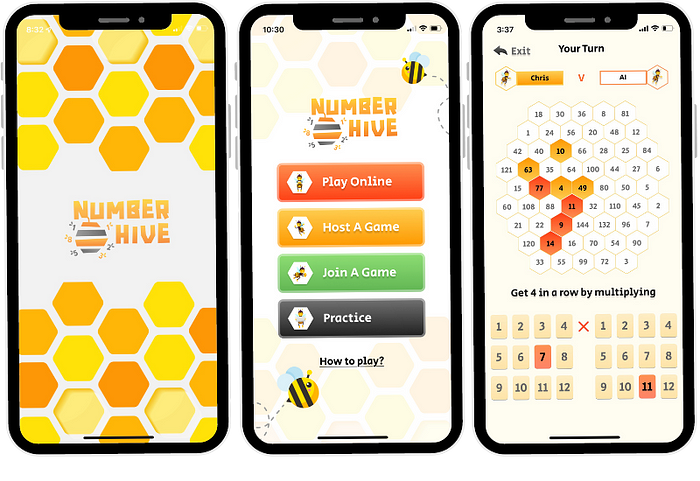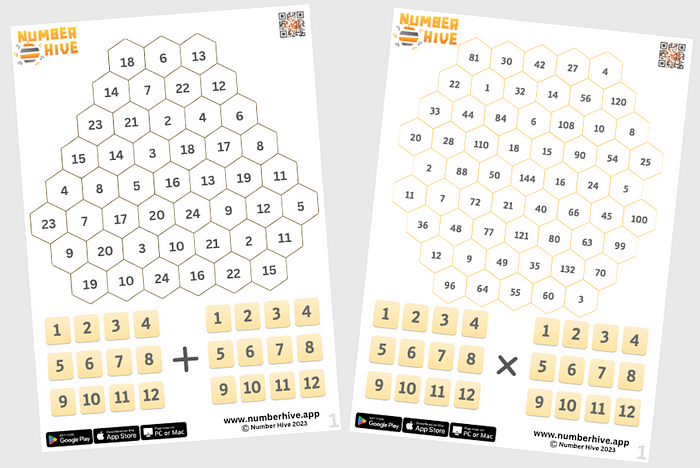Number Hive: The Clever Gamification of Factual Fluency

I have two teenagers. It’s still up in the air how much mathematics will intersect their lives in the future. But, since they were old enough to understand, I told them that for me, the attraction and power of mathematics comes down to two things: numbers and algebra. The further and farther we were away from all things school is when I — paradoxically somewhat — emphasized this even more.
If we were out for dessert somewhere, and my kids were shovelling cake and ice cream into their mouths, I would talk numbers(usually primes) and algebra. If I took them sledding, I would sometimes ramble off some random math fact/philosophy.
I wanted their memories of mathematics to be intertwined to happy moments. I didn’t want it hitched to a dining room table in the evening doing homework. Sigh. That does happen. But, my voice only gets positively animated if their is something of interest. Since they are both knee-deep in algebra, all three of us have happy smirks. They now understand how powerful algebra is — and how logical and elegant it is.
But, before all that, I wanted my kids to have a solid confidence in multiplying. Yes, knowing their math facts was important. What was more important was to wanting to multiply with creative flexibility. All those italicized words are important. Whether they got the correct answer was almost immaterial.
What’s 17 x 9? I would say in an exaggerated voice “that’s too hard!” I would say let’s try 17 x 10. Then I would pause, and say in the same exaggerated/cartoonish voice, “hmmm…that hard too”. I would finally get down to 17 x 1.
17. Let’s put our zero back in that we took out.
170. Our question only called for nine of those 17’s. We have one extra.
170 subtract 17. Take away 10 first. 160. Now take away 7.
153.
I must have told number stories/strategies like this hundreds of times since they were both young — always ensuring that I included the most number of steps. In time, they would bypass a few of them. Today, I just listen to their strategies. Even though my son has a calculator — and is a bit lazy by nature — he still wants to multiply stuff in his head. Sometimes his calculations fall apart in his head and makes a mistake. So immaterial. That’s thirty seconds of his axons and neurons firing off in his brain trying to solve something like 23 x 12.
Which brings me to Number Hive, a creation of Christopher Hogbin, a mathematics teacher in the UK. I sure wish I had this when my kids were young. It is exactly the way I would want multiplication presented to kids — fun, exploratory, and engaging.
The goal of the game is simple, and so are the rules:
Claim four cells in a row. Claim a cell using your multiplying skills. Factors can be changed one at a time, taking turns.
Remember to try and block your opponent.
But, the game has a hidden depth that you can only uncover by repeated play. Repeated. Isn’t that what we are trying to do, albeit in the most boring and sterile ways in school, when we ask kids to memorize their times tables?
In addition to the addictive gameplay, there are some other components of Number Hive that make it attractive for me:
- Hexagonal Cells

The hexagon is an important shape, especially in nature. So having the game board be tiled like this, not only connects it to the game name, but also to a future familiarity with a very famous triangle that is associated with people like Pingala, Yang Hui, Omar Khayam, Tartaglia, and finally Pascal.
2. Familiar Numbers From Times Tables Chart That Are Scattered
Kids are, rightfully so, bored with the standard times tables chart. It represents such an inert and joyless representation of mathematics — one which is sadly not dislodged by school. Having the numbers distributed randomly in the cells adds to the intrigue and intrinsic, strategic survey of where some key numbers might be.
3. Strategic Flexibility
This is what makes this game so powerful. You can’t be anchored to any original strategy. Soon as your opponent claims a cell, you need to do at least a casual recalibration of what the Hive board looks like in terms of your initial strategy. Is it still good? Does it need to be adjusted for some defense at this point? What numbers are left? 108 is important — what multiplies to it!?
4. Various Challenge Levels
I love how in Easy mode, there is little need to consider defense. Just claim four cells in a row with your multiplication skills. Gain some confidence with that first — the essential, foundational skill. Once that is fairly solid, introducing another layer of thinking — blocking opponents/defense — is organically adopted.
For all the information on the game, just go to https://www.numberhive.app/
Have fun buzzing around with fun multiplication!
